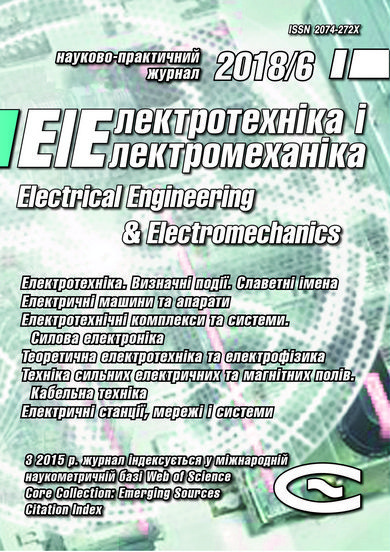APPLICATION OF VYSHNEGRADKY'S DIAGRAMS FOR TRANSIENT ANALYSIS IN ELECTRIC DISCHARGE INSTALLATIONS WITH STOCHASTIC LOAD
DOI:
https://doi.org/10.20998/2074-272X.2018.6.06Keywords:
electric discharge installation, capacitor discharge, transients, Vyshnegradsky's diagram, stochastic loadAbstract
Purpose. To analyze the transient processes in the discharge circuit of reservoir capacitor of electric discharge installations at a change in the circuit configuration during the discharge as well as to determine the appropriate circuit parameters for which the discharge process described by the third-order differential equation remains a damped oscillatory process. Methodology. We have applied the concepts of theoretical electrical engineering, the principles of theory of electrical circuits, theory of automatic control systems and mathematical simulation in the software package MathCAD 12. Results. We have obtained the analytical expressions and graphical dependencies that allow us to determine a relationship between the value of the element parameters of the discharge circuit of installations with an additional active-inductive chain and the character of the transient discharge process without solving a third-order differential equation. Originality. Using Vyshnegradsky's criteria and their graphical representations in the form of diagrams, we have proposed the procedure for determining the inductance value in additional chain shunting the capacitor of electric discharge installation in order to avoid the undesirable aperiodic discharge transient process in the stochastic load. Practical value. The use of this approach makes it possible to determine the ranges of the expedient change in the additional inductance at different load resistances for the realization of transient process required by the technology – the oscillatory discharge of the reservoir capacitor trough the load.References
1. Shcherba А.А. Printsipy postroeniia i stabilizatsii parametrov poluprovodnikovyh elektroimpulsnyh sistem elektroiskrovogo dispergirovaniia sloia tokoprovodiashchih materialov. Stabilizatsiia parametrov elektricheskoi energii. [Principles of the construction and stabilization of the parameters of semiconductor electro-pulse systems of electro-spark dispersion of a layer of conductive materials. Stabilization of electrical energy parameters]. Kyiv,Institute ofElectrodynamics ofAcademy ofSciences ofUkraine Publ., 1991, pp. 12-30. (Rus).
2. Casanueva R., Azcondo F.J., Branas C., Bracho S. Analysis, Design and Experimental Results of a High-Frequency Power Supply for Spark Erosion. IEEE Transactions on Power Electronics, 2005, vol.20, no.2, pp. 361-369. doi: 10.1109/tpel.2004.842992.
3. Sen B., Kiyawat N., Singh P.K., Mitra S., Ye J.H., Purkait P. Developments in electric power supply configurations for electrical-discharge-machining (EDM). The Fifth International Conference on Power Electronics and Drive Systems PEDS 2003. Singapore, 17-20 November 2003, vol.1, pp. 659-664. doi: 10.1109/PEDS.2003.1282955.
4. Ivashchenko D.S., Shcherba A.A., Suprunovska N.I. Analyzing probabilistic properties of electrical characteristics in the circuits containing stochastic load. Proceedings IEEE International Conference on Intelligent Energy and Power Systems (IEPS-2016), June 7-11, 2016, Kyiv, Ukraine, pp. 45-48. doi: 10.1109/IEPS.2016.7521887.
5. Nguyen P.-K., Jin S., Berkowitz A. E. MnBi particles with high energy density made by spark erosion. Journal of Applied Physics, 2014, vol.115, no.17, p. 17A756. doi: 10.1063/1.4868330.
6. Shcherba A.A., Suprunovska N.I. Study features of transients in the circuits of semiconductor discharge pulses generators with nonlinear electro-spark load. Proceedings IEEE International Conference on Intelligent Energy and Power Systems (IEPS-2014), June 2-6, 2014, Kyiv, Ukraine, pp. 50-54. doi: 10.1109/IEPS.2014.6874200.
7. Shydlovska N.А., Zakharchenko S.M., Cherkasky О.P. Physical prerequisites for constructing mathematical models of electrical resistance of plasma-erosion loadings. Technical electrodynamics, 2017, no.2. pp. 5-12. (Ukr). doi: 10.15407/techned2017.02.005.
8. Shcherba A.A., Suprunovska N.I., Ivashchenko D.S. Modeling of nonlinear resistance of electro-spark load taking into account its changes during discharge current flowing in the load and at zero current in it. Technical electrodynamics, 2014, no.5, pp. 23-25. (Rus).
9. Besekersky V.А., Popov Ye.P. Teoriia sistem avtomaticheskogo regulirovaniia [Theory of automatic control systems].Moscow, Nauka Publ., 1975. 768 p. (Rus).
10. Demirchian K.S., Neiman L.R., Korovkin N.V., Chechurin V.L. Teoreticheskie osnovy elektrotekhniki[Theory of Electrical Engineering].St.Petersburg, Piter Publ., 2009. 512 p. (Rus).
Downloads
Published
How to Cite
Issue
Section
License
Copyright (c) 2018 N. I. Suprunovska, M. A. Shcherba

This work is licensed under a Creative Commons Attribution-NonCommercial 4.0 International License.
Authors who publish with this journal agree to the following terms:
1. Authors retain copyright and grant the journal right of first publication with the work simultaneously licensed under a Creative Commons Attribution License that allows others to share the work with an acknowledgement of the work's authorship and initial publication in this journal.
2. Authors are able to enter into separate, additional contractual arrangements for the non-exclusive distribution of the journal's published version of the work (e.g., post it to an institutional repository or publish it in a book), with an acknowledgement of its initial publication in this journal.
3. Authors are permitted and encouraged to post their work online (e.g., in institutional repositories or on their website) prior to and during the submission process, as it can lead to productive exchanges, as well as earlier and greater citation of published work.





